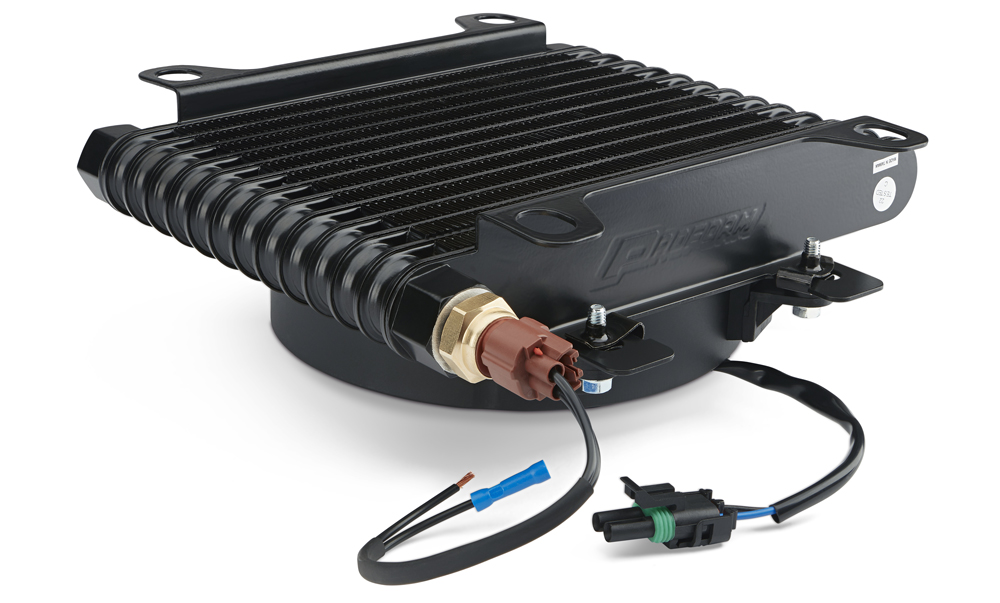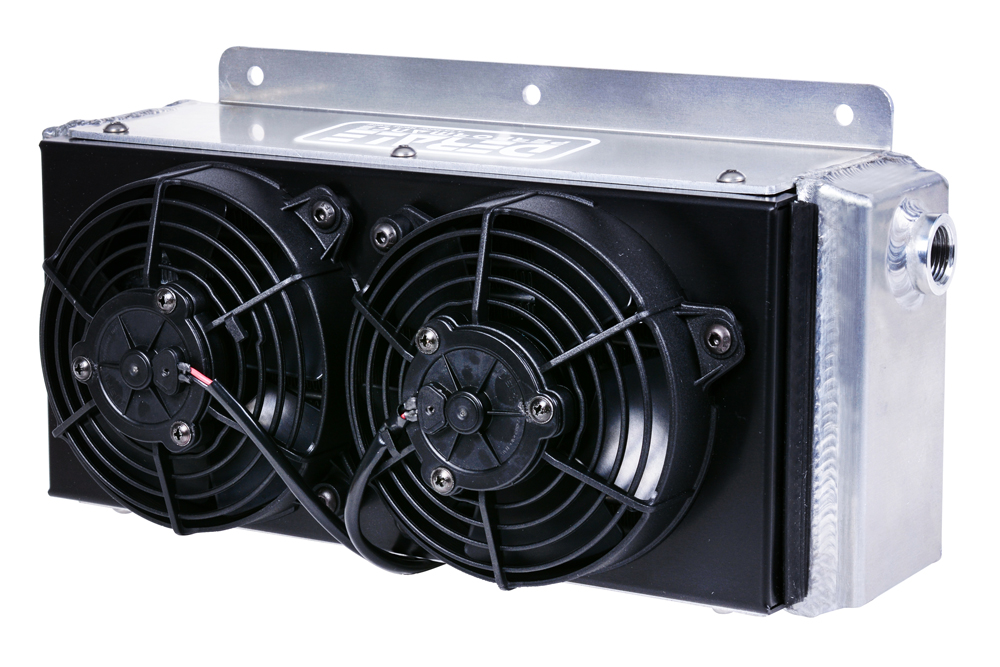Ask the Experts: Remote Cooler Tech
Space constraints can limit the size of a remote cooler “depending on where it’s going,” said Derale’s Cameron Brandt. “Engine oil you can’t over-cool, so whatever you can fit in the space available will be perfect.”
Racing is hot business. A remote cooler will increase cooling capacity for vital fluids and offers a variety of mounting options.
“The name of the game is surface area.”
In a nutshell, Tom Longo of Derale Performance in Los Angeles, California, described one of the two main benefits of installing a remote cooler for engine oil, transmission fluid, or any other drivetrain-related liquid prone to overheating in racing’s extreme environments.
“The main thing a remote cooler does is provide increased surface area for a high-temperature fluid to have contact with the air to remove heat,” added Derale’s Cameron Brandt.
The other benefit? “If you’re strapped for space in the front of your vehicle, a remote cooler can be mounted, well, remotely, to add extra cooling capacity in a different location,” explained Ryan Salata of PROFORM, Warren, Michigan. With an auxiliary fan attached to provide airflow, the cooler can be mounted anywhere, “even under the vehicle.”
“It doesn’t matter how fast you’re going or how slow you’re going, it’s going to get the same amount of airflow,” Longo pointed out. “That’s the main benefit of a remote cooler versus a ram-air cooler. It has its own airflow source.”
Cooler Sizing
Most remote coolers, including those made by Derale and PROFORM, are marketed based on external dimensions and also on how many cooling rows the unit has to pass fluid through. Both companies offer coolers that range from 10 to 40 rows.
“Most guys try to get the biggest secondary cooler they can that will fit,” Salata said. “Our 12- to 16-row coolers are the most popular, but if you can fit the 40-row, do it.”
“Space constraints can limit the size of the cooler depending on where it’s going,” Brandt agreed, “but the more rows you have, the more surface area you’re pulling heat from. Engine oil you can’t over-cool, so whatever you can fit in the space available will be perfect.”
Sizing a transmission cooler is a little more complex, Longo said. “We look at a number of different factors, including the converter, stall speed, vehicle weight, horsepower, gear ratios, and other things.”

“For drag race applications, we will usually upsize the cooler if the car is using a trans brake,” Brandt said. “That way if you get caught sitting on the brake, you don’t burn down the transmission.”
If a racer has any questions about sizing an ATF cooler, “we recommend calling us,” Longo said. “The techs working in the department know what works and what doesn’t for similar configurations.”
The number of rows is important, as is their design. Many coolers have rows made of tube-and-fin construction, while coolers with stacked plate, or plate-and-fin, rows are becoming more popular. “Tube and fin is the traditional affordable design with straightforward construction,” Brandt said. “It’s going to hold more fluid. But the main benefit of going with a stacked plate design is that it gets the fluid really thin to go through that plate, so you get a lot more surface contact. The efficiency goes up a lot.”
Mounting Tips
Mounting a remote cooler is very straightforward. All of PROFORM’s coolers, and many of Derale’s coolers, come with built-in mounting brackets. “You pretty much take it right out of the box and bolt it up to the floor pan, inner fender, anywhere you’re planning to mount it,” Brandt said. “They are more or less set up to go out of the box.”
“It can be as simple as two cross braces that meet our mounting surfaces and you’re done,” Longo said. “It’s relatively easy for a racer to install a remote cooler, as most have some sort of a tube chassis or a roll cage to mount them to.”
One caveat mentioned in PROFORM’s installation instructions is to be wary of mounting the cooler to chassis or frame-rail components that may flex during vehicle operation, as that could lead to leaks or cooler failure. PROFORM recommends the use of rubber isolation mounts for installation.

The coolers from both of these companies that are fitted with fans also come with thermostats to control their use. “We pioneered the thermal switch in the 1990s,” Longo said of Derale’s inline thermostat, which automatically turns on the fan to maintain 180-degree temperatures. “It’s an important piece of the puzzle. How else do you turn it on otherwise? A lot of guys want to run it to a manual switch, but if you do that, you can forget to turn it on. This is automatic and super reliable.”
As for hoses and fittings to connect the cooler, “we sell thousands and thousands and thousands of remote coolers, and probably the majority are using rubber hoses,” Longo said. Years ago, Derale struck a deal with Goodyear to supply “high-pressure, high-temperature rubber hose that would be sufficient for anything we’d throw at it.” However, “most racers aren’t putting on rubber hoses. It depends on the type of racing, and some classes require more braided lines than others, but anything in the middle to high end from us is coming with AN fittings on it. AN fittings are going to make a better seal, but the cooler will be just as efficient either way.”
As a category, “remote coolers is our largest growing segment, and it has been for many years,” Longo said. “Race cars spend a lot of time in the pits, they’re at the start line, they’re in cautions. There are a lot of times when they’re not running at full speed. The beauty of a remote cooler is that you’re getting maximum airflow at any vehicle speed. You’re constantly maintaining temperature no matter what.”
Sources
Derale Performance
derale.com
PROFORM
proformparts.com
 MEMBERSHIP LOGIN
MEMBERSHIP LOGIN JOIN PRI
JOIN PRI


